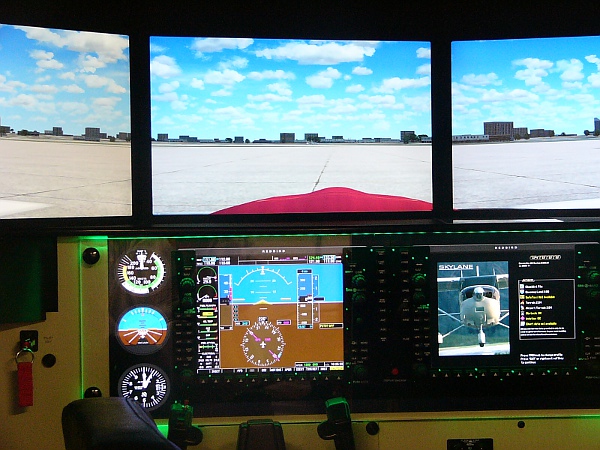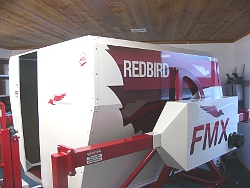Technology lands at Northern Air
|
|
December 15, 2012 |
 |
|
The pilot's
view of the glass-panel cockpit display
and looking out the "windshield" of
Northern Air's new Redbird FMX Flight
Simulator. The view outside is what
you'd see if you were taking off from
New York's La Guardia Airport. |
|
Since early November, there have been several
serious incidents at the Boundary County
Airport, but no one’s read about them until now.
Pilots flying in severe weather beyond their
experience or ability and crashing, numerous
incidences of equipment malfunction or failure.
All right at our small airport at Three Mile.
The Federal Aviation Administration knows all
about it; instead of being alarmed, they’re glad
to see it. Despite all these adverse incidents,
no pilots or passengers have been hurt, no cargo
lost, no aircraft damaged. In fact, the only
damage done so far is a bit of wounded pride and
some sheepish grins.
Each and every one of these incidents, and many
more besides, occurred in a room not much bigger
than the den in an average home, still being
finished off the main terminal, part of what a
bit over a month ago was part of the pilot’s
lounge. It houses an unprepossessing white box
on a red frame, an amazing piece of technology
that is going to revolutionize what the flight
instructors at Northern Air can offer their
students, whether beginning or advanced.
 The
Redbird FMX Flight Simulator is a full-motion
flight simulator that offers a flight experience
differing very little from the thrill of real
flight. Inside that 16-foot by 16-foot box,
local students from beginner to advanced can
take off in any one of four aircraft common in
Boundary County, Idaho, get the feel of flight
almost exactly as if in the air, with the exact
flight characteristics of the aircraft chosen,
be it Northern Air’s standard trainer, the
Cessna 172, the Cessna 182 G-100, the Cirrus
SR-22 or the Piper Seneca Twin. The
Redbird FMX Flight Simulator is a full-motion
flight simulator that offers a flight experience
differing very little from the thrill of real
flight. Inside that 16-foot by 16-foot box,
local students from beginner to advanced can
take off in any one of four aircraft common in
Boundary County, Idaho, get the feel of flight
almost exactly as if in the air, with the exact
flight characteristics of the aircraft chosen,
be it Northern Air’s standard trainer, the
Cessna 172, the Cessna 182 G-100, the Cirrus
SR-22 or the Piper Seneca Twin.
The FMX is built to simulate a real aircraft,
with all the controls and breakers you’d find in
a real cockpit. Changing “planes” is as easy as
changing the digital “glass panel” display
that’s replacing the analog “six pack” array of
gauges most long-time pilots grew up with. You
can change the yoke to a side-stick. And what
you see out the “windshield” is pretty close to
what you’ll see over the cowling of a real
airplane.
You can simulate taking off and landing from any
airport in America, you can experience in-flight
emergencies, anything from adverse weather, loss
of visibility, circuit failure, engine loss …
all without ever leaving the ground.
And instead of a National Transportation Safety
Board investigation in the event of a “crash,”
you have a well-shaken pilot who understands
what went wrong, and why.
“This is an amazing tool,” said Northern Air
office manager Ashley Glaza, who is using the
FMX to earn her commercial flight certificate.
“You can do and experience things you’d never
want to do in a real aircraft. The motion makes
it realistic.”
The FMX cost about as much as the aircraft
Northern Air uses as a trainer, but it’s going
to save student pilots considerably, both in
time and in money.
“You don’t have fuel costs, you don’t have to
replace tires,” said chief flight instructor
Nathaniel Cheshire. "It’s not tied to the
weather, you don’t have to cancel a flight
because it’s snowing or windy outside. When days
are short in the winter, you can extend daylight
‘flying’ time. It’s going to save students a
ton.”
He tells of a veteran pilot, a stunt pilot, in
fact, who recently had to fly on a set schedule
to Phoenix, but who needed to certify on the
glass panel display. The weather forecasts
looked less than ideal, so he wanted to hone his
instrument rating skills, where you fly on your
instruments alone, with no outside visual
references.
“We set up a two day crash course for him,”
Cheshire said. “At the end of the second day, he
‘flew’ the entire trip in the simulator, in the
same weather conditions the forecasts were
predicting. The next day, he actually made the
flight.”
Cheshire and fellow flight instructors Dave
Parker and Carla Dedera are all certified on the
FMX by the FAA, and already the flight simulator
is being used in all phases of flight training.
With the next Northern Air ground school
starting up January 7, Cheshire is excited about
what students will experience.
“We’ll be giving free sim rides to students, and
during the course there are things you have to
see to understand,” he said. “This gives us that
capability.”
A successful sim flight requires everything
necessary in a real flight; you have to use maps
and charts, right down to taxi maps of the
airports or strips. Unlike a real flight,
however, the Redbird FMX has two feature no
airplane does, “pause” and “rewind.”
“As an instructor, I can program scenarios while
the student pilot is at the controls,” he said.
“Just like in real flight, the student has to
evaluate options, weigh risks and make
decisions. If they make the wrong decision, they
will ‘crash,’ but be able to walk away. I have
the ability to either allow the crash or to
pause and back up, to let them work through the
problem, understand their limitations and those
of the aircraft they’re flying.”
Not only will this unprepossessing white box,
sitting in a small and safe room just off the
terminal at Boundary County Airport, wielded by
experienced instructors, save students time and
money, particularly those who’ve never flown
before, it will make them a better and safer
pilot once they roll down the runway and soar
off into the sky.
To find out more about the Redbird FMX Flight
Simulator, flight training at Northern Air or
all the many ways Northern Air brings the
benefit of aviation to Boundary County, visit
www.northernair.biz, stop by the airport,
64602 Highway 2, or call (208) 267-4359.
|
|
Questions or comments about this
article?
Click here to e-mail! |
|
|
|
|

